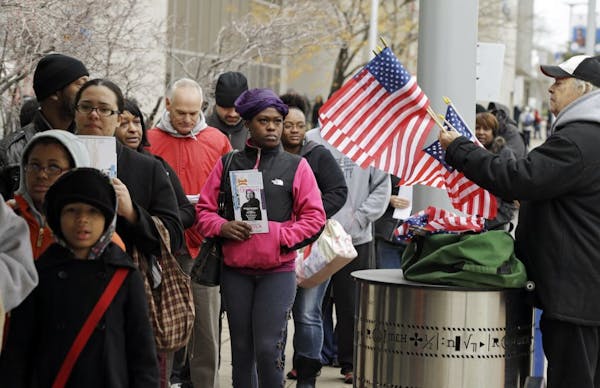Absentee voting across Minnesota is close to the historic levels hit four years ago, state officials said Monday, another sign of intense voter interest in today's election.
The secretary of state's office said it had accepted 235,205 ballots by Monday, a pre-election tally close to historic levels recorded four years ago.
"We're getting close and there will be a lot more," office spokeswoman Patricia Turgeon said Monday, adding that she expects the number of this year's absentee ballots will match the 293,830 absentee ballots cast in 2008.
The gap is expected to close after officials count the ballots submitted Monday, typically the heaviest day for absentee voting.
The early interest is likely to carry over into Tuesday, said Secretary of State Mark Ritchie. He predicts Minnesotans energized by a competitive presidential race and two hotly debated constitutional amendments will once again lead the nation in voter turnout with 3 million people, or nearly 80 percent of those eligible, casting ballots today.
Ramsey County Elections Manager Joe Mansky disagreed. The last two presidential elections were historic, he said, but this year things feel "just normal."
On Monday, only 492 people walked up to submit an absentee ballot, compared with 1,193 who showed up the day before the election in 2008.
"Our turnout is going to go down tomorrow compared to 2004 and 2008 and this is one indication of it," he said. "Our voter registration is also down from 2008."
Record turnout not expected
Since 1996, Minnesota has led all other states in voter participation in general elections, Turgeon said.
For the last three presidential elections, voter turnout was 70.11 percent in 2000, 78.77 percent in 2004 and 78.09 percent in 2008.
But even with the two proposed constitutional amendments -- one asks whether voters should have to show photo identification at the polls and the other proposes changing the state Constitution to define marriage as a union only between a man and a woman -- the 2012 election doesn't appear to be stoking voters' interest to the historic levels of recent years, Mansky said.
"Personally, I've always been of the view that it's the race for president that is driving our turnout. The amendments, they're there, but clearly more votes will get cast for president than for the amendments," he said.
University of Minnesota professor Larry Jacobs agreed that the atmosphere has changed.
"The level of enthusiasm and excitement for Obama is clearly down from what it was in 2008 so that may also be a factor," he said.
"The issue with the amendments is that they did add to the level of interest and engagement but probably not dramatically."
Who benefits from absentee voting is anybody's guess these days.
Jacobs says one indicator is where the ballots are cast. Overseas ballots, he said, tend to come from military personnel and they tend to lean Republican.
But consider the recent U.S. Senate election between Democrat Al Franken and incumbent Norm Coleman, a Republican. Franken won more of the absentee ballots in an extremely close election.
"That was dramatic," Jacobs said. "Franken was literally behind until we started counting the ballots."
Allie Shah • 612-673-4488

